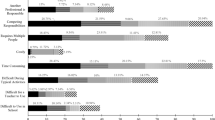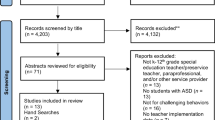Abstract
The study developed and provided evidence of content validity, internal consistency, and factor structure of the Inventory of Teaching Challenges for Inclusive Physical Education (ITC-IPE) with children with autism spectrum disorders. Content validity of the ITC-IPE was established by seven content experts. A background questionnaire and the ITC-IPE were administered to two samples: a pilot sample of 220 certified physical educators and a validation sample of 253 certified physical educators. Teachers rated teaching challenges using a difficulty scale and a frequency scale. Findings revealed four factors (task-related challenges, social behavior challenges, environmental challenges, and challenges related to narrow interest and inflexibility), which explained 60% of the variance for both scales. Internal consistency ranged between .88 and .94. All factors were inter-correlated.
Similar content being viewed by others
References
Allison, P. D. (1987). Estimation of linear models with incomplete data. In C. C. Clogg (Ed.), Sociological methodology (pp. 71–103). San Francisco: Jossey-Bass.
American Psychiatric Association (APA). (2000). Diagnostic and statistical manual of mental disorders (4th ed.). Washington, DC: Author.
Benson, J., & Clark, F. (1982). A guide for instrument development and validation. American Journal of Occupational Therapy, 36, 789–800.
Bentler, P. M., & Chou, C. P. (1987). Practical issues in structural modeling. Sociological Methods & Research, 16, 78–117.
Brown, T. A. (2006). Confirmatory factor analysis for applied research. New York: Guilford.
Browne, M. W., & Cudeck, R. (1993). Alternative ways of assessing model fit. In K. A. Bollen & J. S. Long (Eds.), Testing structural equation models (pp. 136–162). Beverly Hills: Sage.
Cattell, R. B. (1978). The scientific use of factor analysis in behavioral and life sciences. New York: Plenum.
Cavell, T. A., & Kelley, M. L. (1992). The measure of adolescent social performance: Development and initial validation. Journal of Clinical Child Psychology, 21, 107–114.
Cronbach, L. J. (1951). Coefficient alpha and the internal structure of tests. Psychometrika, 16, 297–334.
D’Zurilla, T. J., & Nezu, A. M. (2006). Problem-solving therapy: A positive approach to clinical Intervention (3rd ed.). New York: Springer Publishing Company.
Emck, C., Bosscher, R., Beek, P., & Doreleijers, T. (2009). Gross motor performance and self-perceived motor competence in children with emotional, behavioral, and pervasive developmental disorders: A review. Developmental Medicine & Child Neurology, 51, 501–517.
Fowler, F. J. (2009). Survey research methods (4th ed.). Thousand Oaks: Sage Publications.
Gable, R. K., & Wolf, M. B. (1992). Instrument development in the affective domain: Measuring attitudes and values in corporate and school settings. Boston: Kluwer Academic Publishers.
Goldfried, M. R., & D’Zurilla, T. J. (1969). A behavioral-analytic model for assessing competence. In C. D. Spielberger (Ed.), Current topics in clinical and community psychology, vol. 1 (p. 1969). New Yourk: Academic.
Grover, R. L., Nangle, D. W., & Zeff, K. R. (2005). The measure of adolescent heterosocial competence: Development and initial construct validation. Journal of Clinical Child and Adolescent Psychology, 34, 282–291.
Groves, R. M., Fowler, F. J., Couper, M. P., Lepkowski, J. M., Singer, E., & Tourangeau, R. (2004). Survey methodology (2nd ed.). Hoboken: Wiley.
Holtmann, M., Bolte, S., & Poustka, F. (2007). Attention deficit hyperactivity disorder symptoms in pervasive developmental disorders: Association with autistic behavior domains and coexisting psychopathology. Psychopathology, 40, 172–177.
Hu, L., & Bentler, M. (1999). Cut-off criteria for fit indexes in covariance structure analysis: Conventional criteria versus new alternatives. Structural Equation Modeling: A Multidisciplinary Journal, 6, 1–55.
James, L. R., Mulaik, S. A., & Brett, J. M. (1982). Causal analysis: Assumptions, models, and data. Beverly Hills: Sage.
Johnson, D., & Johnson, R. (1999). Learning together and alone: Cooperative, competitive, and individualistic learning. Boston: Allyn and Bacon.
Jöreskog, K. G., & Sörbom, D. (2006). LISREL 8.80 for Windows, Scientific Software International. Lincolnwood, IL.
Kogan, M. D., Blumberg, S. J., Schieve, L. A., Boyle, C. A., Perrin, J. M., Ghandour, R., et al. (2009). Prevalence of parent-reported diagnosis of autism spectrum disorder among children in the US, 2007. Pediatrics, 124, 1–9.
Lynn, M. R. (1986). Determination and quantification of content validity. Nursing Research, 35, 382–385.
Mardia, K. V. (1970). Measures of multivariate skewness and kurtosis with applications. Biometrika, 36, 519–553.
Matson, J. L., & Nebel-Schwalm, M. (2007). Assessing challenging behaviors in children with autism spectrum disorders: A review. Research in Developmental Disorders, 28, 567–579.
McCaughtry, N., Tischler, A., & Barnard Flory, S. (2008). The ecology of the gym: Reconceptualized and extended. Quest, 60, 268–289.
Messick, S. (1989). Validity. In R. L. Linn (Ed.), Educational measurement (3rd ed., pp. 13–103). New York: Macmillan Publishing Co, Inc; American Council on Education.
Müller, E., Schuler, A. L., & Yates, G. B. (2008). Social challenges and supports from the perspective of individuals with Asperger syndrome and other autism spectrum disabilities. Autism, 12, 173–190.
Nunnally, J. C. (1978). Psychometric theory (2nd ed.). New York: McGraw-Hill.
Obrusnikova, I., & Cavalier, A. (2011). Perceived barriers and facilitators of participation in after-school physical activity by children with autism spectrum disorders. Journal of Developmental and Physical Disabilities, 23, 195–211.
Obrusnikova, I., & Dillon, S. R. (2011). Challenging situations when teaching children with autism spectrum disorders in general physical education. Adapted Physical Activity Quarterly, 28, 113–131.
Polit, D. F., & Beck, C. T. (2006). The content validity index: Are you sure you know what’s being reported? Critique and recommendations. Research in Nursing & Health, 29, 489–497.
Portney, L. G., & Watkins, M. P. (2000). Foundations of clinical research applications to practice (2nd ed.). Upper Saddle River: Prentice Hall Health.
Reid, G., & O’Connor, J. (2003). The autism spectrum disorders: Activity selection, assessment, and program organization. Palaestra, 19, 20–27. 58.
Shaked, M., & Yirmiya, N. (2003). Understanding social difficulties. In M. Prior (Ed.), Learning and behavior problems in asperger syndrome (pp. 126–147). New York: Guilford.
Sharma, U., Loreman, T., & Forlin, C. (2011). Measuring teacher efficacy to implement inclusive practices. Journal of Research in Special Educational Needs, 11: no. doi: 10.1111/j.1471-3802.2011.01200.x
Siedentop, D., & Tannehill, D. (2000). Developing teaching skills in physical education. Mountain View: Mayfield Publishing Company.
Suomi, J., Collier, D., & Brown, L. (2003). Factors affecting the social experiences of students in elementary physical education classes. Journal of Teaching Physical Education, 22, 186–202.
Taliaferro, A., & Block, M. E. (2010). Validation of an instrument to explore physical educators’ beliefs toward inclusion. Application of Self-efficacy theory. Riverside: North American Federation on Adapted Physical Activity.
Tripp, A., & Rizzo, T. L. (2006). Disability labels affect physical educators. Adapted Physical Activity Quarterly., 23, 310–326.
United States Census Bureau. (2010). Census regions and divisions of the United States. Retrieved May 25, 2010, from http://www.census.gov/geo/www/us_regdiv.pdf.
VanFleet, D. D., & Atwater, L. (1997). Gender neutral names: Don’t be so sure! Sex Roles, 37, 111–123.
Zhang, J., & Griffin, A. J. (2007). Including children with autism in general physical education: Eight possible solutions. Journal of Physical Education, Recreation, and Dance, 78(3), 33–37. 50.
Acknowledgements
This project was made possible through funding from the Research Consortium of the American Alliance for Health, Physical Education, Recreation and Dance Seed Grant and the University of Delaware General University Grant.
Author information
Authors and Affiliations
Corresponding author
Rights and permissions
About this article
Cite this article
Obrusnikova, I., Dillon, S.R. Validation of the Inventory of Teaching Challenges for Inclusive Physical Education: Autism Spectrum Disorders. J Dev Phys Disabil 23, 563–579 (2011). https://doi.org/10.1007/s10882-011-9249-x
Published:
Issue Date:
DOI: https://doi.org/10.1007/s10882-011-9249-x




